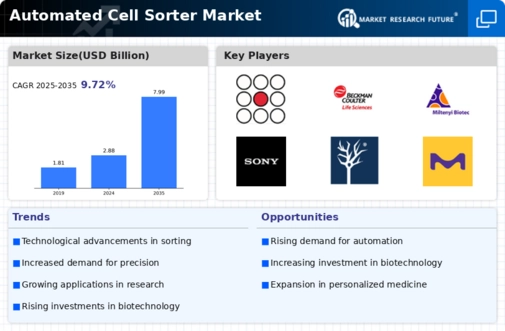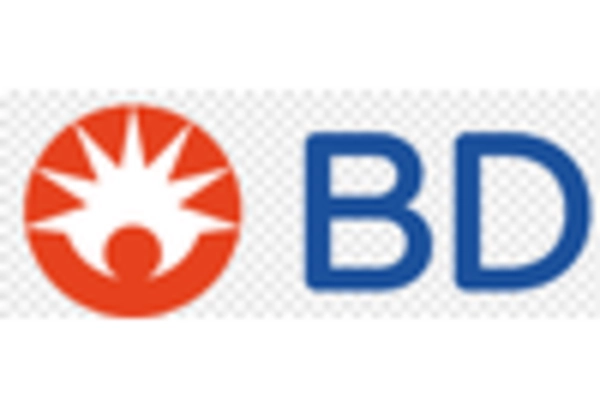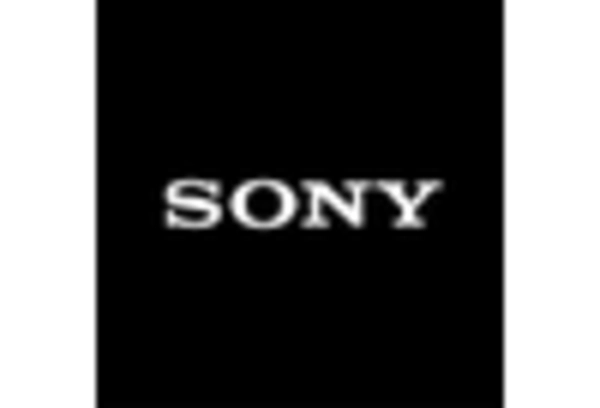Technological Advancements in Automated Cell Sorter Market
The Automated Cell Sorter Market is experiencing rapid technological advancements that enhance sorting efficiency and accuracy. Innovations such as microfluidics and laser-based sorting technologies are becoming increasingly prevalent. These advancements allow for the precise separation of cells based on various parameters, including size, shape, and surface markers. As a result, the market is projected to grow significantly, with estimates suggesting a compound annual growth rate (CAGR) of over 10% in the coming years. Furthermore, the integration of artificial intelligence and machine learning into sorting systems is likely to optimize workflows and reduce operational costs, thereby attracting more research institutions and laboratories to adopt automated cell sorting solutions.
Rising Demand for Personalized Medicine in Automated Cell Sorter Market
The shift towards personalized medicine is a key driver in the Automated Cell Sorter Market. As healthcare moves towards tailored therapies, the need for precise cell sorting becomes paramount. Automated cell sorters facilitate the identification and isolation of specific cell types, which is crucial for developing personalized treatment plans. The market is witnessing an increase in demand for these technologies, particularly in oncology and immunotherapy, where targeted therapies require accurate cell characterization. This trend is expected to propel market growth, with projections indicating that the personalized medicine sector could account for a substantial share of the overall market by 2026, further emphasizing the importance of automated cell sorting technologies.
Increased Focus on Research and Development in Automated Cell Sorter Market
The Automated Cell Sorter Market is benefiting from an increased focus on research and development across various sectors, including biotechnology and pharmaceuticals. As organizations strive to innovate and improve their product offerings, the demand for advanced cell sorting technologies is on the rise. Research institutions are investing heavily in developing new applications for automated cell sorting, which is likely to lead to breakthroughs in areas such as regenerative medicine and stem cell research. This heightened R&D activity is expected to drive market expansion, with analysts forecasting that investments in automated cell sorting technologies will increase significantly over the next few years, thereby enhancing the overall market landscape.
Growing Applications in Clinical Diagnostics within Automated Cell Sorter Market
The applications of automated cell sorting in clinical diagnostics are expanding, which is a notable driver for the Automated Cell Sorter Market. These technologies are increasingly utilized for the analysis of blood samples, enabling the rapid identification of specific cell populations associated with various diseases. The rise in chronic diseases and the need for efficient diagnostic tools are propelling the adoption of automated cell sorters in clinical laboratories. Market data indicates that the clinical diagnostics segment is expected to witness substantial growth, potentially reaching a valuation of several billion dollars by 2027. This trend underscores the critical role of automated cell sorting in enhancing diagnostic accuracy and efficiency.
Increasing Investment in Biotechnology and Pharmaceutical Sectors in Automated Cell Sorter Market
Investment in the biotechnology and pharmaceutical sectors is a significant driver for the Automated Cell Sorter Market. As these sectors continue to grow, the demand for advanced technologies, including automated cell sorting, is likely to increase. Companies are recognizing the value of these systems in streamlining research processes and improving product development timelines. The market is witnessing a surge in funding for biotech startups and established pharmaceutical companies focusing on innovative therapies, which in turn drives the need for efficient cell sorting solutions. Analysts predict that this trend will lead to a robust market environment, with investments in automated cell sorting technologies expected to rise substantially over the next few years.


















Leave a Comment